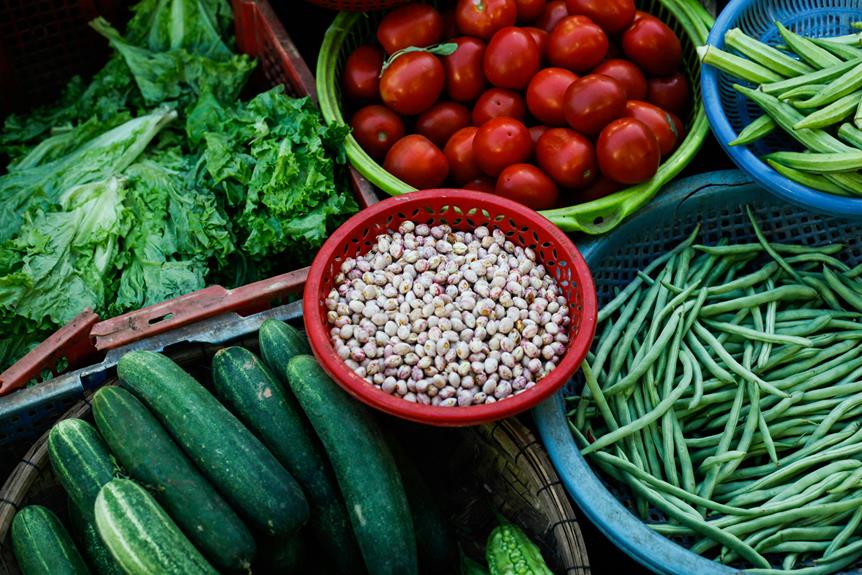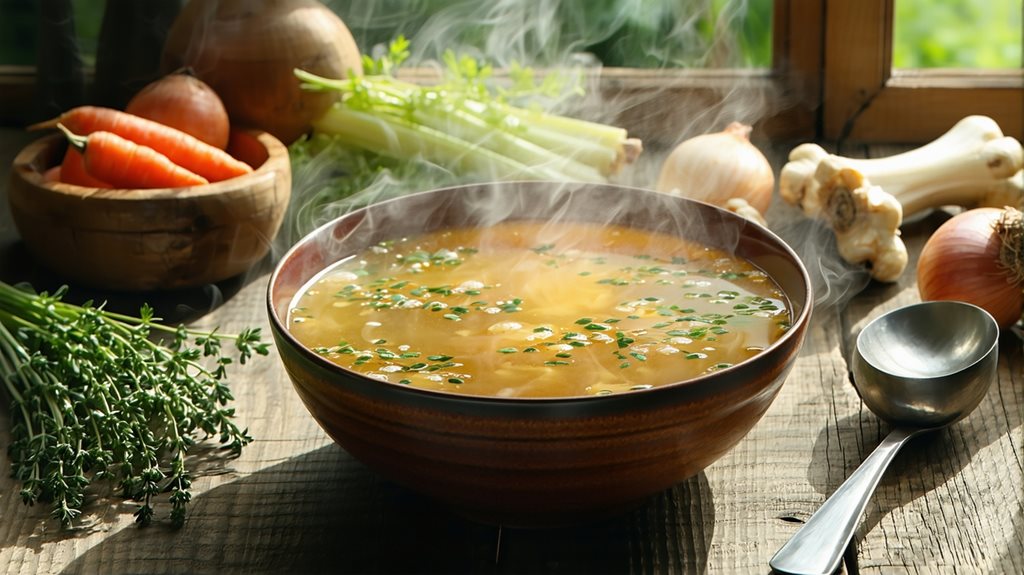Did you know that the compact nature of Aerogarden Harvest makes it ideal for cultivating tomatoes, even in limited spaces? You'll need to select the right varieties—think 'Tiny Tim' or 'Red Robin'—that thrive in smaller, controlled environments. Inserting the seed pods correctly and managing the growth conditions are vital steps that you can't overlook. But how do you handle challenges like adequate pollination and ensuring your plants receive the right nutrients without overcomplicating the process? Stick around to uncover some effective strategies that could greatly boost your tomato yield.
Key Takeaways
- Tomatoes can be grown in an Aerogarden Harvest using compact, high-yield seed varieties.
- The Aerogarden provides ideal growth conditions with adjustable LED lights offering 16-18 hours of daily light.
- Ensure proper water and nutrient management by monitoring levels and adding nutrients bi-weekly.
- Manual pollination techniques, such as using a brush, are necessary as Aerogardens do not attract natural pollinators.
- Pruning and care, including removing excess leaves and pinching off suckers, are crucial for healthy tomato growth in Aerogardens.
Choosing the Right Tomato Seeds
When selecting tomato seeds for your Aerogarden Harvest, opt for varieties known for their compact growth and high yield. You'll want to guarantee that the types you choose can thrive in the more controlled, soil-free environment of a hydroponic system. Varieties like 'Tiny Tim,' 'Red Robin,' and 'Yellow Canary' are specifically bred for small spaces and won't overwhelm your Aerogarden. These types aren't only manageable but also produce a generous amount of fruit, offering you both convenience and productivity.
It's critical to select seeds from a reliable source to ensure germination and health of the plants. Look for suppliers who offer high germination rates and who are well-reviewed by other indoor gardeners. This assures you're not wasting your time or resources on seeds that won't perform up to your expectations.
Moreover, consider the disease resistance of the varieties you select. Tomatoes that are resistant to common pathogens such as fusarium and verticillium wilts will give you a more robust control over your garden's health, minimizing the need for chemical interventions.
Setting Up Your Aerogarden Harvest
You'll need to assemble your Aerogarden Harvest before planting your chosen tomato the seeds. Start by finding a suitable location for the unit. It requires access to a power outlet and should be placed where it can receive ambient light, though not direct sunlight, which can affect the temperature and growth consistency.
Once you've picked the spot, unpack all components of your Aerogarden. You'll find the main reservoir base, the grow deck, a lamp arm, and the LED grow light. Begin by attaching the lamp arm to the base. It should click into place securely, giving you total control over the stability of your setup.
Next, attach the grow light to the arm. Ensure it's firmly in place to avoid any sagging or instability.
Now, fill the reservoir with water up to the fill line marked inside. This precision ensures your tomatoes receive the exact amount of water they need, no guesswork involved.
After adding water, plug the unit into the nearest outlet. You're setting the stage for ideal growth conditions, guaranteeing your tomatoes have the resources they need right from the start.
Inserting the Seed Pods
Insert the seed pods into the labeled slots on your Aerogarden's grow deck, ensuring each pod is seated firmly. This step is vital as it directly impacts the germination and overall health of your tomato plants. You'll want to make sure each pod is pushed down until it's snug, avoiding any gaps that could affect the pod's exposure to the water and nutrients essential for growth.
Handling the seed pods correctly puts you in control of the early stages of your plant's development. Here's a quick checklist to guide you through this process:
- Ensure Correct Orientation: The label side of the seed pod should face upwards, making it easier to monitor growth and maintain.
- Check Firmness: After inserting, give each pod a gentle push to ensure it's not loose.
- Avoid Overcrowding: Space the pods evenly. This prevents competition for light and nutrients as the plants grow.
- Label Each Pod: Use markers or stickers to note which variety of tomato you've planted in each slot. This helps in tracking their growth stages and needs.
Ideal Growth Conditions
To guarantee your tomato plants thrive, maintain a consistent environment with ideal light, temperature, and humidity. Your Aerogarden Harvest offers you precise control over these elements, ensuring ideal conditions for growth. Let's explore what each factor entails.
Firstly, lighting is essential. Tomatoes need about 16 to 18 hours of light daily to maximize their growth potential. Fortunately, the Aerogarden's built-in LED lights are designed to mimic natural sunlight, promoting healthier, robust plants. You can adjust the light's intensity and duration directly on your unit, tailoring the exposure to suit your tomatoes' specific needs.
Temperature plays a significant role as well. Tomatoes prefer a warmer climate, ideally between 65°F and 75°F. Your indoor Aerogarden allows you to easily maintain this range, free from the unpredictability of outdoor weather conditions.
Lastly, consider the humidity. Tomatoes thrive in moderate humidity, around 40-60%. This level helps in the prevention of common issues like blossom end rot. Use a small room humidifier or a dehumidifier to keep the air around your Aerogarden within this range, depending on your local climate conditions.
Managing Water and Nutrients
Now that you've set the ideal conditions, let's focus on how to manage water and nutrients for your tomato plants in the Aerogarden Harvest. Managing these factors is essential for thriving plants, and you're in full control here.
First, always make sure the water level is at its best. Your Aerogarden will alert you when it's time to add water, but it's wise to check manually every few days. Tomatoes are thirsty, and consistent water levels help prevent stress that could hinder growth.
Next, nutrient management is key. Aerogarden's liquid nutrients are tailored for a hydroponic setup, ensuring your tomatoes get exactly what they need. Here's a straightforward guide to keep your plants flourishing:
- Monitor Water Levels Regularly: Check every 2-3 days to ensure the water level is within the best range.
- Add Nutrients Bi-weekly: Follow the Aerogarden instructions to add nutrients every two weeks. This keeps nutrient levels stable.
- Adjust pH Only if Necessary: Use a pH testing kit. Tomatoes prefer a pH of 5.5-6.5. Adjust only if it drifts outside this range.
- Observe Plant Health: Changes in plant color or growth can indicate water or nutrient issues. Adjust accordingly.
Pruning and Care Tips
Trimming your tomato plants in the Aerogarden Harvest is vital for promoting healthy growth and maximizing yield. By regularly pruning, you'll direct the plant's energy towards producing larger, more robust tomatoes rather than wasting resources on excessive leafy growth.
Start by removing any leaves that look yellowed or diseased. This not only improves air circulation but also minimizes the risk of fungal infections that can devastate your crop.
Focus on the suckers, which are small shoots that grow between the stem and a branch. If left unchecked, they'll sap energy from the main fruit-producing branches. Pinch these suckers off with your fingers when they're small, ideally less than three inches long. This action encourages your plants to focus more on fruit than foliage.
Keep an eye on the top of your plant. Once it reaches the maximum height of your Aerogarden Harvest, it's time to top it off. This means cutting off the topmost growth point. It might seem drastic, but it's essential for keeping your plants under control and encouraging them to put more energy into fruiting.
Pollination Techniques
After mastering the art of pruning your tomato plants, you'll need to make sure they're properly pollinated to produce fruit. In the confined environment of an Aerogarden, natural pollinators like bees aren't an option, so you'll have to take charge of pollination yourself. This might sound challenging, but it's quite manageable and gives you complete control over your plant's productivity.
Here's how you can ensure effective pollination:
- Use a small brush or cotton swab: Gently brush the inside of each flower, mimicking the motion of a bee. This transfers pollen from the stamens to the pistil, stimulating fertilization.
- Employ a battery-operated pollinator: These handy devices mimic the vibration caused by a bee's wings, which is highly effective at releasing pollen.
- Tap the branches: Lightly shaking the branches can also release pollen. Do this gently to avoid damaging the plant.
- Optimize your garden's environment: Make sure your Aerogarden has adequate airflow as this helps pollen circulate. Adjusting the fans or occasionally opening near windows can facilitate this process.
Harvesting Your Tomatoes
Once your tomato plants begin to show red, ripe fruit, it's time to start harvesting. You've nurtured your plants from seedlings, and now you can reap the rewards. Approach this step with strategy to maximize your yield and maintain the health of your Aerogarden.
Firstly, only pick tomatoes that are fully colored. This guarantees they've reached their peak flavor and nutrient content. Gently grasp the fruit and twist it lightly until it snaps off the vine. If you tug too hard, you might damage the plant. Remember, your control over these actions directly impacts the quality of your harvest.
You'll need to check your plants daily. Tomatoes ripen at different rates, and timely harvesting prevents overripening. Overripe tomatoes can attract pests or start to rot, affecting the health of your entire garden. By keeping a close eye and harvesting ripe tomatoes regularly, you maintain control over the garden environment.
Troubleshooting Common Issues
Despite your best efforts, you might encounter some common issues while growing tomatoes in your Aerogarden Harvest. But don't worry, you've got this! Here's how you can tackle each problem with precision and regain control of your garden:
- Poor Growth or Yellow Leaves: This often signals a nutrient deficiency. Make sure you're replacing the nutrient solution every two weeks and adjusting the pH if necessary. A balanced environment will promote healthier growth.
- Weak Flowering: If your tomato plants aren't producing vibrant flowers, they mightn't be getting enough light. Boost the light exposure by adjusting the LED lights closer to the plants but avoid touching the leaves to prevent scorching.
- Pest Infestations: Keep an eye out for signs of pests like aphids or whiteflies. If you spot any, act swiftly by applying an organic insecticide or introducing natural predators like ladybugs into your Aerogarden.
- Fungal Diseases: Prevent fungal diseases by ensuring the air circulation is adequate in your growing area. If signs of fungus appear, remove affected plants and treat the area with a fungicidal spray.
With these proactive steps, you'll maintain the upper hand and keep your tomato plants thriving in their Aerogarden habitat.





Konnichiwa! (Hello!) I'm Pat Tokuyama, a Japanese tofu cookbook author, who travels for music, food, and adventure. If you like Japanese tea, checkout some of the newestorganic japanese tea, matcha bowls and noren and more!
** Curious about the Plant Based Japanese Cooking Club? ** Learn more here!